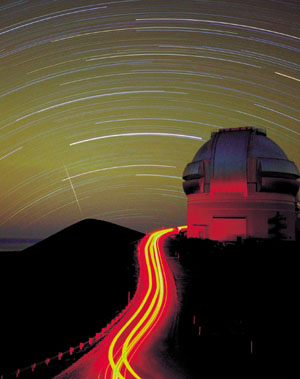Edited by Emma Sanders
Gemini to see furthest stars
Cosmology gains a twin as the first of two new international telescopes starts observations. The Gemini pair will explore the skies in both the northern and southern hemispheres at optical and infrared wavelengths.

With better infrared resolution than any other telescope, Gemini will be used to make new observations of the furthest galaxies, the light of which is shifted to the red by the expansion of the universe. The telescopes will also be used for high-resolution spectroscopy, to improve measurements such as the primordial lithium abundance a fingerprint left by the first 100 s of the universe’s existence.
Gemini North is situated on Hawaii’s Mauna Kea and will make its first scientific observations next year. Its sister telescope, Gemini South, is being built on Chile’s Cerro Pachón and is expected to see first light by 2001. Partners in the project are the UK, the US, Canada, Chile, Australia, Brazil and Argentina.
Gemini observations will complement those made with ESO’s Very Large Telescope (VLT), which is under construction in Chile. Gemini North will be considerably more sensitive in the mid-infrared range owing to the cooler, higher altitude site, which means less background noise.
A Gemini telescope in both hemispheres means that there will be complete sky coverage at all times. However, from 2005 the six VLT telescopes will be used as interferometers, capable of revealing finer detail than Gemini. Like the VLT, Gemini’s 8.1 m mirrors use adaptive optics to correct for distortions to starlight passing through the atmosphere. This gives a spatial resolution three times as good as the 2.4 m Hubble Space Telescope at near-infrared wavelengths.





